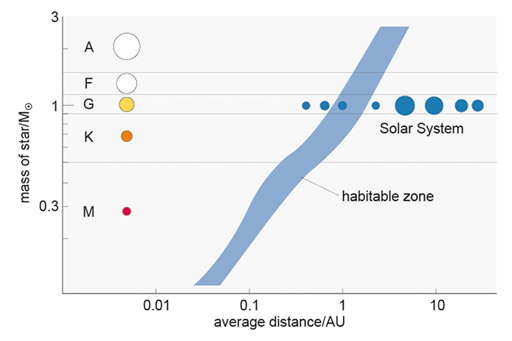4.1 Habitable zone
Is where we are (half way along a spiral arm in an undistinguished galaxy) particularly special? Has the origin of life on Earth been enabled because of the type of star our planet orbits, and where that star sits within the Galaxy?
This brings us to the concept of a habitable zone. This is a region within a planetary, stellar or galactic system where conditions are sufficiently suitable and stable to allow life to arise. A habitable zone is often taken to mean a place where liquid water can exist.
The blue band in the image above is the region within a planetary system where water would be liquid on the planet’s surface. The position of this region is a trade-off between the size (or temperature) of the star and the distance a planet is away from the star.
So a planet orbiting a star hotter than the Sun would have to be further away from its star than the Earth is from the Sun in order for water to be liquid. As you can see from the diagram above, Jupiter would be just outside the habitable zone of an A-type star (such as Sirius), while Mars would be well inside the habitable zone. Similarly, a planet orbiting a star cooler than the Sun would have to be closer in than the Earth is to the Sun.
In the next section, you will find out what makes the Sun the ‘right type of star’ to allow life to have arisen on at least one of the planets in orbit around it.

